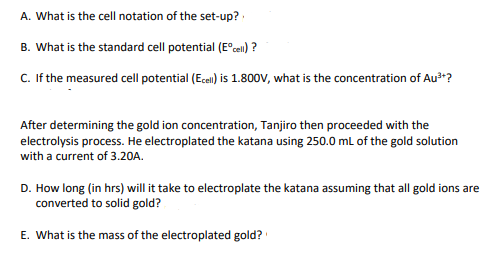A. What is the cell notation of the set-up? B. What is the standard cell potential (Eºcell)? C. If the measured cell potential (Ecell) is 1.800V, what is the concentration of Au³+?
A. What is the cell notation of the set-up? B. What is the standard cell potential (Eºcell)? C. If the measured cell potential (Ecell) is 1.800V, what is the concentration of Au³+?
Organic Chemistry
8th Edition
ISBN:9781305580350
Author:William H. Brown, Brent L. Iverson, Eric Anslyn, Christopher S. Foote
Publisher:William H. Brown, Brent L. Iverson, Eric Anslyn, Christopher S. Foote
Chapter27: Amino Acids And Proteins
Section: Chapter Questions
Problem 27.50P
Related questions
Question
![3.
Tanjiro, a Chem 17.1 student, found a prehistoric katana during his trip to
Japan. He inspected the katana and realized that it was made out of gold. Upon closer
inspection, Tanjiro noticed that it had a lot of chips and scratches, signifying that it had
been used in battle long ago. Wanting to restore the katana to its original state, Tanjiro
used his knowledge in Chem 17.1 to electroplate gold into the surface of the katana using
an ore his father found on their backyard. Tanjiro proceeded with the electroplating
process, however, he realized that the concentration of the gold ions present in the
solution is unknown, making the electroplating process difficult to plan. He then decided
to use a galvanic cell to obtain the gold ion concentration. He used the half-cell reactions
below:
Au³+ (aq) + 3e → Au(s)
E° = +1.520V
E° = -0.230V
Ni²+ (aq) + 2e → Ni(s)
Given:
[Ni²+] = 0.050 M
FMNI = 58.69 g/mol
FMAU = 196.97 g/mol](/v2/_next/image?url=https%3A%2F%2Fcontent.bartleby.com%2Fqna-images%2Fquestion%2F62841455-5e85-4457-ae26-4828fa264c00%2Fc6c20c07-734f-4ad5-b65d-f94b71c2fa29%2Fzwul66_processed.png&w=3840&q=75)
Transcribed Image Text:3.
Tanjiro, a Chem 17.1 student, found a prehistoric katana during his trip to
Japan. He inspected the katana and realized that it was made out of gold. Upon closer
inspection, Tanjiro noticed that it had a lot of chips and scratches, signifying that it had
been used in battle long ago. Wanting to restore the katana to its original state, Tanjiro
used his knowledge in Chem 17.1 to electroplate gold into the surface of the katana using
an ore his father found on their backyard. Tanjiro proceeded with the electroplating
process, however, he realized that the concentration of the gold ions present in the
solution is unknown, making the electroplating process difficult to plan. He then decided
to use a galvanic cell to obtain the gold ion concentration. He used the half-cell reactions
below:
Au³+ (aq) + 3e → Au(s)
E° = +1.520V
E° = -0.230V
Ni²+ (aq) + 2e → Ni(s)
Given:
[Ni²+] = 0.050 M
FMNI = 58.69 g/mol
FMAU = 196.97 g/mol

Transcribed Image Text:A. What is the cell notation of the set-up?
B. What is the standard cell potential (Eºcell)?
C. If the measured cell potential (Ecell) is 1.800V, what is the concentration of Au³+?
After determining the gold ion concentration, Tanjiro then proceeded with the
electrolysis process. He electroplated the katana using 250.0 mL of the gold solution
with a current of 3.20A.
D. How long (in hrs) will it take to electroplate the katana assuming that all gold ions are
converted to solid gold?
E. What is the mass of the electroplated gold?
Expert Solution
This question has been solved!
Explore an expertly crafted, step-by-step solution for a thorough understanding of key concepts.
Step by step
Solved in 2 steps with 2 images

Knowledge Booster
Learn more about
Need a deep-dive on the concept behind this application? Look no further. Learn more about this topic, chemistry and related others by exploring similar questions and additional content below.Recommended textbooks for you

Organic Chemistry
Chemistry
ISBN:
9781305580350
Author:
William H. Brown, Brent L. Iverson, Eric Anslyn, Christopher S. Foote
Publisher:
Cengage Learning

Organic Chemistry: A Guided Inquiry
Chemistry
ISBN:
9780618974122
Author:
Andrei Straumanis
Publisher:
Cengage Learning

Organic Chemistry
Chemistry
ISBN:
9781305580350
Author:
William H. Brown, Brent L. Iverson, Eric Anslyn, Christopher S. Foote
Publisher:
Cengage Learning

Organic Chemistry: A Guided Inquiry
Chemistry
ISBN:
9780618974122
Author:
Andrei Straumanis
Publisher:
Cengage Learning